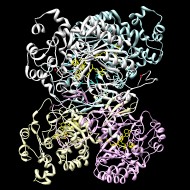Family known  |
|||||||
| Total |
100%  |
<100%  |
Family unknown  |
||||
| Functional domains | 2679 | 1829 | 7 | 843 | |||
| UniProtKB | 7595 | 0 | 6877 | 718 | |||
| GI | 14666 | 12812 | 19 | 1835 | |||
| Structures | 1 | ||||||
| Reactions | 0 | ||||||
| Functional domains of this subgroup were last updated on June 10, 2017 | |||||||
| New functional domains were last added to this subgroup on June 22, 2014 | |||||||
All the proteins in this subgroup appear to be PLP-dependent and are thought to carry out B12-like rearrangements. Whilst the best chcracterised of this set are the lysine 2,3-aminomutases, it is currently unclear if all the enzymes in this set are aminomutases. They all bind SAM via the canonical CxxxCxxC motif. The putative families in this subgroup have been determined by using an E() Value cut-off of 1E-75
Lepore BW, Ruzicka FJ, Frey PA, Ringe D
The x-ray crystal structure of lysine-2,3-aminomutase from Clostridium subterminale
▸ Abstract
Proc Natl Acad Sci U S A 2005;102(39):13819-13824 | PubMed ID: 16166264
Ruzicka FJ, Frey PA
Glutamate 2,3-aminomutase: a new member of the radical SAM superfamily of enzymes
▸ Abstract
Biochim Biophys Acta 2006;1774(2):286-296 | PubMed ID: 17222594
No notes.
Static File Downloads
| File Name | Description | Parameters | Stats |
|---|---|---|---|
| repnet.sg1070.th50.pE20.mek250.xgmml | Representative network: each node is a group of similar sequences | node similarity threshold = 50 max edge count = 250 min -log10 E = 20 |
size = 4.4M num_edges = 9626 num_nodes = 149 |
| sfld_alignment_sg1070.msa | Annotated Sequence Alignment, Stockholm format | 187 sequences size: 117K |
Total number of functional domains in this group.
Number of Functional Domains that have been manually or automatically been assigned to a family.
Number of Functional Domains that have not been assigned to a family.
Number of structures available from the PDB for members of this group.
Number of Functional Domains with 100% of Conserved Residues
Number of Functional Domains with less than 100% Conserved Residues
| Subgroup ▸ Legend | T  |
K  |
C  |
U  |
S  |
||
|---|---|---|---|---|---|---|---|
| PLP-dependent | 2679 | 1836 | 1829 | 843 | 1 | ||
| ┗ arginine 2,3-aminomutase | 26 | 26 | 26 | 0 | |||
| ┗ glutamate 2,3-aminomutase | 72 | 72 | 71 | 0 | |||
| ┗ L-lysine 2,3-aminomutase (LAM-like) | 402 | 402 | 401 | 1 | |||
| ┗ L-lysine 2,3-aminomutase (yjeK like) | 1336 | 1336 | 1331 | 0 |
Depth of the multi-level Subgroup hierarchy.



